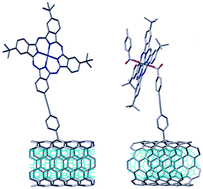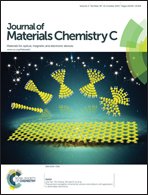Peripheral versus axial substituted phthalocyanine-double-walled carbon nanotube hybrids as light harvesting systems†
Abstract
Selective functionalization of the outer walls of double-walled carbon nanotubes (DWCNTs) with zinc and silicon phthalocyanines leaving the inner walls undamaged has been accomplished. The mode of metal phthalocyanine (MPc) connection was varied, that is, through the macrocycle periphery in the case of zinc phthalocyanines (ZnPcs) and through the silicon axial position in the case of silicon phthalocyanines (SiPcs) to visualize its effect on phthalocyanine–DWCNT interactions. Evidence of outer wall functionalization and the degree of phthalocyanine substitution on DWCNTs were arrived from HR-TEM, AFM, TGA, XPS and Raman techniques. The sensitizer-nanotube interactions were probed from studies involving optical absorbance, steady-state and time resolved emission, and electrochemical studies. The fluorescence of phthalocyanines in these hybrids was found to be almost quantitatively quenched (>95%) due to the interactions with DWCNTs, and such interactions were more for the SiPc derived hybrids. The femtosecond transient absorption studies performed revealed that the interactions are dynamic involving the singlet excited phthalocyanines and the nanotubes. In agreement with earlier studies, evidence for charge separation in these hybrids was bleak revealing weak signature bands of MPc˙+ in the 850 nm range. Additionally, the presence of trace amounts of single-walled carbon nanotubes in the hybrids further hampered detailed spectral analysis.


 Please wait while we load your content...
Please wait while we load your content...